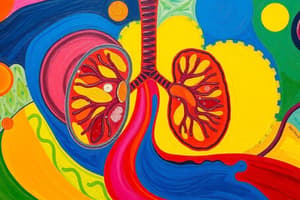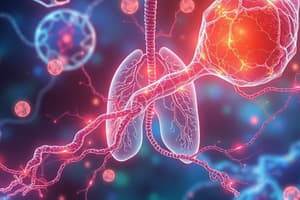Podcast
Questions and Answers
What is the primary function of cellular respiration?
What is the primary function of cellular respiration?
- To synthesize proteins from amino acids.
- To produce glucose for energy storage.
- To break down water into hydrogen and oxygen.
- To release chemical energy (ATP) from sugars and other carbon-based molecules. (correct)
Which of the following best describes the process of glycolysis?
Which of the following best describes the process of glycolysis?
- The conversion of pyruvate into carbon dioxide and water.
- The formation of large quantities of ATP molecules.
- The synthesis of glucose from carbon dioxide and water.
- The breakdown of glucose into two pyruvate molecules. (correct)
Where does glycolysis take place in the cell?
Where does glycolysis take place in the cell?
- In the endoplasmic reticulum
- In the cytoplasm (correct)
- In the nucleus
- In the mitochondria
What is a key characteristic of glycolysis in terms of oxygen requirements?
What is a key characteristic of glycolysis in terms of oxygen requirements?
If sufficient oxygen is available, what process follows glycolysis in cellular respiration?
If sufficient oxygen is available, what process follows glycolysis in cellular respiration?
In aerobic cellular respiration, where does the Krebs cycle take place?
In aerobic cellular respiration, where does the Krebs cycle take place?
Which of these best describes the role of the Electron Transport Chain (ETC) in aerobic cellular respiration?
Which of these best describes the role of the Electron Transport Chain (ETC) in aerobic cellular respiration?
What are the products of aerobic cellular respiration?
What are the products of aerobic cellular respiration?
Which of the following correctly matches a stage of cellular respiration with its location in the cell?
Which of the following correctly matches a stage of cellular respiration with its location in the cell?
What is the primary role of oxygen in aerobic respiration?
What is the primary role of oxygen in aerobic respiration?
How many ATP molecules are produced directly during the Krebs cycle for each molecule of glucose that enters cellular respiration?
How many ATP molecules are produced directly during the Krebs cycle for each molecule of glucose that enters cellular respiration?
In the absence of oxygen, what process allows glycolysis to continue to produce a small amount of ATP?
In the absence of oxygen, what process allows glycolysis to continue to produce a small amount of ATP?
Which of the following is NOT a product of the Krebs cycle?
Which of the following is NOT a product of the Krebs cycle?
What are the end products of lactic acid fermentation?
What are the end products of lactic acid fermentation?
If a cell can only undergo alcoholic fermentation, which substance would the cell produce?
If a cell can only undergo alcoholic fermentation, which substance would the cell produce?
What is the net gain of ATP molecules produced by glycolysis?
What is the net gain of ATP molecules produced by glycolysis?
According to the diagram, what is a reactant in glycolysis?
According to the diagram, what is a reactant in glycolysis?
Which stage of cellular respiration produces the most ATP molecules?
Which stage of cellular respiration produces the most ATP molecules?
Flashcards
What is cellular respiration?
What is cellular respiration?
Cellular respiration is a process that releases chemical energy (ATP) from sugars and other carbon-based molecules. In simpler terms, it's the process of breaking down food to make energy.
What happens before cellular respiration?
What happens before cellular respiration?
Before cellular respiration, food molecules are broken down into smaller molecules. For example, carbohydrates are broken down into glucose.
What is glycolysis?
What is glycolysis?
Glycolysis is the process of splitting glucose into two three-carbon molecules called pyruvate. This process occurs in the cytoplasm and does not require oxygen.
What is aerobic cellular respiration?
What is aerobic cellular respiration?
Signup and view all the flashcards
Where does aerobic cellular respiration take place?
Where does aerobic cellular respiration take place?
Signup and view all the flashcards
What is the Krebs Cycle?
What is the Krebs Cycle?
Signup and view all the flashcards
What is the electron transport chain?
What is the electron transport chain?
Signup and view all the flashcards
What is the overall equation for aerobic cellular respiration?
What is the overall equation for aerobic cellular respiration?
Signup and view all the flashcards
Glycolysis
Glycolysis
Signup and view all the flashcards
Krebs Cycle (Citric Acid Cycle)
Krebs Cycle (Citric Acid Cycle)
Signup and view all the flashcards
Electron Transport Chain (ETC)
Electron Transport Chain (ETC)
Signup and view all the flashcards
Aerobic Respiration
Aerobic Respiration
Signup and view all the flashcards
Anaerobic Respiration
Anaerobic Respiration
Signup and view all the flashcards
Fermentation
Fermentation
Signup and view all the flashcards
Lactic Acid Fermentation
Lactic Acid Fermentation
Signup and view all the flashcards
Alcoholic Fermentation
Alcoholic Fermentation
Signup and view all the flashcards
Photosynthesis
Photosynthesis
Signup and view all the flashcards
Interdependence of Photosynthesis and Respiration
Interdependence of Photosynthesis and Respiration
Signup and view all the flashcards
Study Notes
Cellular Respiration Overview
- Cellular respiration is the process of releasing chemical energy (ATP) from sugars and other carbon-based molecules. It's essentially breaking down food to create energy.
Stages of Aerobic Respiration
-
Glycolysis: This is the first stage, where glucose is broken down into two three-carbon molecules called pyruvate. Glycolysis occurs in the cytoplasm and doesn't require oxygen. It produces a net gain of 2 ATP molecules.
-
Krebs Cycle (Citric Acid Cycle): The pyruvate molecules from glycolysis are further broken down, releasing carbon dioxide. This happens in the matrix of the mitochondria. This stage produces a small amount of ATP, NADH, and FADH2.
-
Electron Transport Chain (ETC): The energy carriers (NADH and FADH2) from glycolysis and the Krebs cycle transfer their energy to the electron transport chain. This occurs in the inner membrane of the mitochondria. Oxygen is essential in this stage, combining with the electrons and hydrogen ions to create water. The ETC produces a significant number of ATP (34-36).
Aerobic vs. Anaerobic Respiration
-
Aerobic respiration: Requires oxygen and creates a considerable amount of ATP (36-38). Occurs in mitochondria.
-
Anaerobic respiration (Fermentation): Does not require oxygen. Produces a much smaller amount of ATP (2). Two types of fermentation are lactic acid fermentation and alcoholic fermentation. Fermentation occurs in the cytoplasm.
Fermentation
-
Lactic Acid Fermentation: Occurs in animal muscle cells when oxygen is low. Pyruvate is converted to lactic acid.
-
Alcoholic Fermentation: Occurs in yeast and some other microorganisms. Pyruvate is converted to alcohol and carbon dioxide.
Photosynthesis and Respiration Relationship
- Photosynthesis and respiration are interconnected. The products of one process (like the sugar produced during photosynthesis) are the reactants for the other (like glucose used during respiration).
- Photosynthesis, which occurs in chloroplasts, uses carbon dioxide and water, and light energy to create sugars and oxygen.
- Respiration, occurring in mitochondria, takes sugars and oxygen to produce carbon dioxide and water, releasing energy.
Summary of Reactants and Products
- Aerobic Respiration: -Reactants: Glucose and Oxygen -Products: Carbon Dioxide, Water, ATP (32-36)
- Anaerobic Respiration (Fermentation): -Reactants: Glucose -Products: Lactic Acid or Ethanol, Carbon Dioxide, ATP (2)
Studying That Suits You
Use AI to generate personalized quizzes and flashcards to suit your learning preferences.




